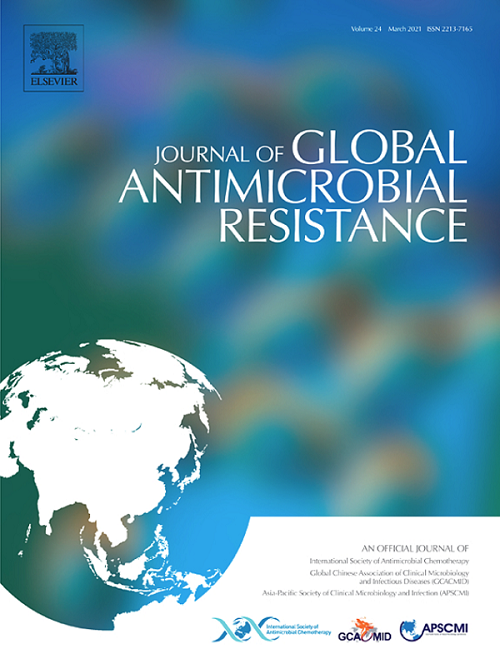2010-2022年美国引起社区获得性尿路感染的大肠杆菌抗菌素耐药性回顾性分析
IF 3.2
3区 医学
Q2 INFECTIOUS DISEASES
引用次数: 0
摘要
目的:回顾性分析2010-2022年美国社区获得性尿路感染(uti)收集的大肠杆菌分离株。这些数据来自SENTRY抗菌药物监测计划,这是一个自1997年以来一直在进行的全球监测计划,目的是跟踪和报告从各种感染源收集的临床分离株的敏感性。方法:采用临床与实验室标准协会(CLSI)指南规定的微量肉汤稀释法,对符合美国疾病控制与预防中心对社区获得性尿路感染定义的分离株进行了对17种抗菌药物的敏感性测试。根据CLSI和欧洲抗微生物药物敏感性测试委员会的断点,将分离物解释为敏感、中间或耐药,并以广谱β-内酰胺酶和多重耐药表型为特征。结果:在整个研究期间,对阿莫西林-克拉维酸酯、甲氧苄啶-磺胺甲恶唑和氟喹诺酮类口服药物敏感的分离株百分比为70%-85%,超过了2010年美国传染病学会指南中甲氧苄啶-磺胺甲恶唑经验使用的可接受阈值80%。所有通过静脉或肌肉注射给药的药物都有较高的易感性(bbb90 %)。不同普查区域的易感性分布存在差异,通常在大西洋中部发现最高的耐药率。结论:这些数据强调了在治疗社区获得性尿路感染时需要更多的口服选择。本文章由计算机程序翻译,如有差异,请以英文原文为准。
Retrospective analysis of antimicrobial resistance among Escherichia coli causing community-acquired urinary tract infections in the United States from 2010 to 2022
Objective
A retrospective analysis of Escherichia coli isolates collected from community-acquired urinary tract infections (UTIs) in the United States for the years 2010–2022 was performed. The data originated from accessing the SENTRY Antimicrobial Surveillance Program, which is a global monitoring program that has been ongoing since 1997 with a purpose of tracking and reporting susceptibility of clinical isolates collected from various infection sources.
Methods
Isolates meeting the Centers for Disease Control and Prevention definition for community-acquired UTI were tested for antimicrobial susceptibility against 17 antimicrobial agents using broth microdilution methodology specified by the Clinical & Laboratory Standards Institute guidelines. Isolates were interpreted as susceptible, intermediate, or resistant as appropriate using Clinical & Laboratory Standards Institute and European Committee on Antimicrobial Susceptibility Testing breakpoints and characterized for extended-spectrum β-lactamase and multidrug-resistant phenotypes.
Results
The percentage of isolates susceptible to the oral agents amoxicillin-clavulanate, trimethoprim-sulfamethoxazole, and fluoroquinolones was 70%–85% throughout the study period, which crosses the acceptable threshold of 80% for empiric use of trimethoprim-sulfamethoxazole per the 2010 Infectious Disease Society of America guidelines. Higher susceptibility (>90%) was observed for all agents administered via intravenous or intramuscular route. Variation in susceptibility profiles was observed by census region, with the highest resistant rates commonly found in the Middle Atlantic.
Conclusions
These data highlight the need for more oral options when treating community-acquired UTIs.
求助全文
通过发布文献求助,成功后即可免费获取论文全文。
去求助
来源期刊

Journal of global antimicrobial resistance
INFECTIOUS DISEASES-PHARMACOLOGY & PHARMACY
CiteScore
8.70
自引率
2.20%
发文量
285
审稿时长
34 weeks
期刊介绍:
The Journal of Global Antimicrobial Resistance (JGAR) is a quarterly online journal run by an international Editorial Board that focuses on the global spread of antibiotic-resistant microbes.
JGAR is a dedicated journal for all professionals working in research, health care, the environment and animal infection control, aiming to track the resistance threat worldwide and provides a single voice devoted to antimicrobial resistance (AMR).
Featuring peer-reviewed and up to date research articles, reviews, short notes and hot topics JGAR covers the key topics related to antibacterial, antiviral, antifungal and antiparasitic resistance.
 求助内容:
求助内容: 应助结果提醒方式:
应助结果提醒方式:


